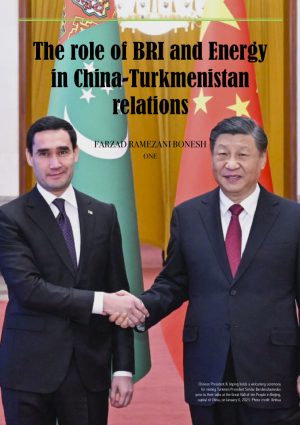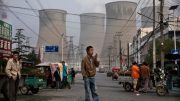 Turkmenistan is located in the southeast of the Caspian region. China and Turkmenistan established diplomatic relations in January 1992.
Turkmenistan is located in the southeast of the Caspian region. China and Turkmenistan established diplomatic relations in January 1992.
Past relationships
China was the first country to establish diplomatic relations with Turkmenistan. The relationship between Turkmenistan and China witnessed the signing of several bilateral agreements and treaties such as the Bilateral Investment Treaty in 1992 and the Double Taxation Agreement in 2009 and numerous official visits.
In the last decade, two countries have expanded their diplomatic presence in the opposite country.
In 2013, intergovernmental relations between Beijing and Ashgabat became strategic. Their relationship was upgraded to a strategic partnership in 2014.
In 2023, officials and leaders of China and Turkmenistan met at a summit, The official visit of the President of Turkmenistan Berdimuhamedov to China in January 2023) was announced as the development of comprehensive strategic cooperation between Turkmenistan and China. Also, several memorandums of understanding were signed in the digital economy, green development, revitalization of the Great Silk Road, and BRI, energy, education, tourism, etc.”
On October 16, 2023, the heads of the two countries jointly announced the promotion of China-Turkmenistan relations to a comprehensive strategic partnership. Turkmenistan appreciated China’s leading role in international governance and announced that it participates in China’s important global initiatives and steps alongside the country.
In 2023, Xi Jinping met with the national leader of Turkmenistan, Gurbanguly Berdimuhamedov at the third high-level forum of the “One Belt, One Road” initiative in Beijing. The signing of Important agreements and documents in this meeting led to the intensification of interregional relations with China’s Xinjiang Autonomous Region, and the further development of bilateral, and multilateral relations in the framework of United Nations and also in the format of ‘Central Asia-China’.
In addition, China supported Turkmenistan in protecting its national sovereignty, security, and interests and pursuing the development path of deepening cooperation and relations, paying attention to the synergy of the “One Belt, One Road” initiative and Turkmenistan’s strategy for revitalizing Great Silk Road, implementing the results of the China Summit and Central Asia.
China-Turkmenistan comprehensive strategic partnership in 2024 has been slowly developed. Supporting each other in development, promoting cooperation in the “One Belt, One Road” initiative, strengthening people-to-people relations, and deepening cooperation in fields such as politics, economy and trade, energy, transportation, and culture are considered by both sides.
The role of BRI and energy
China is expanding and relatively deepening BRI cooperation in Turkmenistan. In the China-Central Asia-West Asia BRI corridor, two of the BRI routes pass through Turkmenistan.
China by using BRI, seeks to expand transportation and logistic infrastructure, trade links, prosperity, new opportunities for stability and growth, investment, technology and new markets, industries, industrial promotion, green and digital economy, reducing electricity shortage etc,.
Turkmenistan is getting closer to China with the signing of the memorandum of cooperation on railway routes with China, the “2024-2025 roadmap” of Turkmenistan, Kazakhstan, Iran, and Russia (upgrading the North-South international transport corridor) and expanding the middle corridor. After May 2023, progress is being made on the construction of the China-Kyrgyzstan-Uzbekistan-Turkmenistan railway.In the first meeting of the heads of C+C5 countries, China also asked Turkmenistan to increase investment and win-win cooperation in BRI and sectors such as energy.
In the sixth meeting of the bilateral cooperation committee in November 2023 in Ashgabat, the two sides emphasized strengthening strategic communication, promoting comprehensive strategic partnership, increasing economic, commercial, and investment cooperation, deepening natural gas cooperation, and consultations on the alignment of priority economic projects, and the early implementation of Luban workshops in Turkmenistan.
A list of agreements on the role of expanding the BRI in the economy of Turkmenistan, infrastructure projects, and other economic sectors is also considered by Beijing. China’s approach is based on the country’s national goals in Turkmenistan and South-South cooperation and is also seen in the service of strengthening BRI.
China’s BRI is under the National Plan of Turkmenistan in 2022-2052 and the Plan in 2022-2028″, “Foreign Trade Strategy 2021-2030”, and attracting large capital to Turkmenistan. Six sub-committees in the fields of trade, energy, humanitarian exchange, security, transportation, and logistics, as well as scientific technology play a coordinated role in the comprehensive implementation of the cooperation program for 5 years (2021-2025).
Turkmenistan has the 4-6 largest natural gas reserves in the world. As China became the world’s largest energy consumer, Turkmenistan can help to diversify energy supply sources for China, reduce coal consumption, energy security, and reduce dependence on the Straits of Malacca.
Turkmenistan exports its natural gas to China through the Central Asia-China gas pipeline or three pipelines from the Turkmenistan-Uzbekistan-Kazakhstan route.
BRI has paid attention to this country by speeding up the implementation of the development of the Galkinish field and the construction of Line D of the Turkmenistan-China gas pipeline. Line D from the Tajikistan-Kyrgyzstan route to China is shorter and more in China’s possession and increases the total annual capacity of the network to 85 billion cubic meters and maintains Turkmenistan’s rank in gas exports to China.
In this regard, China has been able to contract and implement mainly in the fields of exploration and development of natural gas and technical services and has access to the Galkinish gas field located in the south of Turkmenistan. Beijing attaches great importance to the planning of CNPC gas trade with Turkmenistan, bioenergy, transport electrification, hydrogen energy, and training of local experts in Turkmenistan.
Ashgabat also needs China to increase gas production in the sea and on the coast, attracting foreign investment, increasing oil production, as well as newly discovered areas in the Caspian region. China is the largest trade partner of Turkmenistan. the balance in bilateral trade is completely in favor of Turkmenistan. The trade turnover of the first quarter of 2024 between Ashgabat and China was approximately 2.6 billion dollars. Turkmenistan accounts for almost 92% of this figure through the sale of natural gas to Beijing.
Obstacles and prospects
Challenges such as the legal status of the Caspian Sea, the policy of strict neutrality and the severe isolation of Ashgabat, the dominance of government institutions over the economy, logistical risks and limitations in infrastructure, and the cost of the $6.7 billion line D, paying gas prices “according to Global pricing are important.
In addition, China denies any ulterior motives in the BRI, but critics of “debt trap diplomacy” rule out imposing harsh conditions on borrowers, the terms of Chinese loans, confidential or unusual clauses, obscurity in details, low-priced gas sales, increased dependence on Beijing considers gas export and provision of foreign exchange resources. Turkmenistan sees China as the most important partner and priority of its foreign policy. With Turkmenistan’s neutral policy, Ashgabat supports the principle of one China, and Beijing’s interests.
However, the bilateral opportunities for both countries are higher than the threats. Special bilateral cooperation and the cooperation of two countries in the energy sector have become the basis of cooperation. Both countries continue to improve trade structure, expand investment, economic and technical cooperation, and strengthen cooperation in emerging fields.
China’s economic growth and Turkmenistan’s abundant reserves complement each other. But Ashgabat’s reliance has increased on China.
The increase in the volume of China-Turkmenistan railway transport, the construction of the China “China-Turkmenistan-Iran” railway corridor, and the expansion of Turkmenistan’s transit trade volume will open more opportunities. Gas cooperation will be the cornerstone of the China-Turkmenistan BRI, and investment in strategic fields such as the chemical industry, transportation, and communication will be expanded and deepened.
Farzad Ramezani Bonesh





